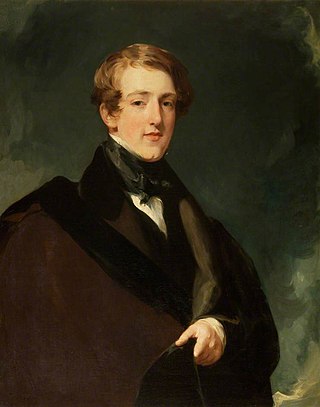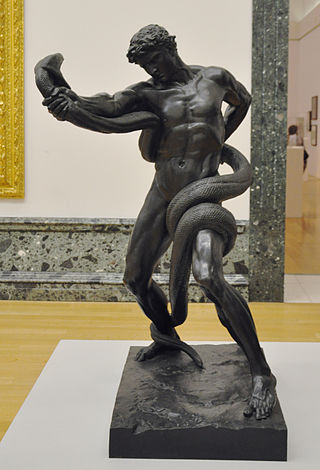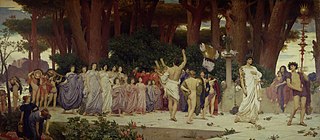
Frederic Leighton, 1st Baron Leighton,, known as Sir Frederic Leighton between 1878 and 1896, was a British painter, draughtsman, and sculptor. His works depicted historical, biblical, and classical subject matter in an academic style. His paintings were enormously popular, and expensive, during his lifetime, but fell out of critical favour for many decades in the early 20th century.

George Frederic Watts was a British painter and sculptor associated with the Symbolist movement. He said "I paint ideas, not things." Watts became famous in his lifetime for his allegorical works, such as Hope and Love and Life. These paintings were intended to form part of an epic symbolic cycle called the "House of Life", in which the emotions and aspirations of life would all be represented in a universal symbolic language.

George Fleming Warren, 2nd Baron de Tabley PC was a British Liberal politician. He notably served as Treasurer of the Household under William Ewart Gladstone between 1868 and 1872.
Admiral Sir Edward Gennys Fanshawe, was a Royal Navy officer who went on to be Commander-in-Chief, Portsmouth. He was a gifted amateur artist, with much of his work in the National Maritime Museum, London.

Cimabue's Celebrated Madonna, originally called Cimabue's [Celebrated] Madonna [is] Carried in Procession through the Streets of Florence, is an oil painting by English artist Frederic Leighton. Measuring more than two metres tall and more than five metres wide, the canvas was painted by Leighton from 1853 to 1855 in Rome as his first major work.

Cymon and Iphigenia is an oil on canvas painting by Frederic Leighton, 1st Baron Leighton. The painting does not bear a date but was first exhibited at the Royal Academy of Arts, London, in 1884. The Art Gallery of New South Wales in Sydney, Australia, purchased it at a Christie's auction in London in 1976.

"Der Fischer" is a ballad by Goethe, written in 1779. Goethe's poem describes an exchange between a fisher and a mermaid who accuses him of luring her brood. As revenge, she enchants him with her song and pulls him into the water.

An Athlete Wrestling with a Python was the first of three bronze sculptures produced by the British artist Frederic Leighton. Completed in 1877, the sculpture was a departure for Leighton, and heralded the advent of a new movement, New Sculpture, taking realistic approach to classical models. It has been described as a "sculptural masterpiece" and as "possibly Leighton's greatest contribution to British art". Despite its indebtedness to the Classical tradition, it can be understood as one of the first stirrings of modern sculpture in Britain as well as in Europe. The Athlete was arguably the most influential piece of English sculpture of the 19th century.
The Bath of Psyche is an oil painting by Frederic Leighton, first exhibited in 1890. It is in the collection of Tate Britain.
Crenaia, the Nymph of the Dargle is an oil painting by Frederic Leighton, first exhibited in 1880. It is in the collection of Juan Antonio Pérez Simón.

The Fisherman and the Syren is an oil painting by Frederic Leighton, first exhibited in 1858. It is a composition of two small full-length figures, a mermaid clasping a fisherman round the neck. The picture is in the collection of the Bristol Museum & Art Gallery.

Venus Disrobing for the Bath is an oil painting by Frederic Leighton, first exhibited in 1867.

Actaea, the Nymph of the Shore is an oil painting by Frederic Leighton, first exhibited in 1868.

Winding the Skein is an oil painting by Frederic Leighton, first exhibited in 1878.

Nausicaa is an oil painting by Frederic Leighton, first exhibited in 1878.

The Music Lesson is an oil painting by Frederic Leighton, first exhibited in 1877.

The Daphnephoria is an oil painting by Frederic Leighton, first exhibited in 1876.

The Syracusan Bride Leading Wild Animals in Procession to the Temple of Diana, also known as A Syracusan Bride Leading Wild Beasts in Procession to the Altar of Diana, is an oil painting by the English artist Frederic Leighton, which was first exhibited at the Royal Academy of Arts in 1866.

Psamathe is an oil painting by Frederic Leighton, first exhibited in 1880.
















